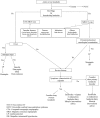Management of Childhood Headache in the Emergency Department. Review of the Literature
- PMID: 31507509
- PMCID: PMC6716213
- DOI: 10.3389/fneur.2019.00886
Management of Childhood Headache in the Emergency Department. Review of the Literature
Abstract
Headache is the third cause of visits to pediatric emergency departments (ED). According to a systematic review, headaches in children evaluated in the ED are primarily due to benign conditions that tend to be self-limiting or resolve with appropriate pharmacological treatment. The more frequent causes of non-traumatic headache in the ED include primitive headaches (21.8-66.3%) and benign secondary headaches (35.4-63.2%), whereas potentially life-threatening (LT) secondary headaches are less frequent (2-15.3%). Worrying conditions include brain tumors, central nervous system infections, dysfunction of ventriculo-peritoneal shunts, hydrocephalus, idiopathic intracranial hypertension, and intracranial hemorrhage. In the emergency setting, the main goal is to intercept potentially LT conditions that require immediate medical attention. The initial assessment begins with an in-depth, appropriate history followed by a complete, oriented physical and neurological examination. The literature describes the following red flags requiring further investigation (for example neuroimaging) for recognition of LT conditions: abnormal neurological examination; atypical presentation of headaches: subjective vertigo, intractable vomiting or headaches that wake the child from sleep; recent and progressive severe headache (<6 months); age of the child <6 years; no family history for migraine or primary headache; occipital headache; change of headache; new headache in an immunocompromised child; first or worst headache; symptoms and signs of systemic disease; headaches associated with changes in mental status or focal neurological disorders. In evaluating a child or adolescent who is being treated for headache, physicians should consider using appropriate diagnostic tests. Diagnostic tests are varied, and include routine laboratory analysis, cerebral spinal fluid examination, electroencephalography, and computerized tomography or magnetic resonance neuroimaging. The management of headache in the ED depends on the patient's general conditions and the presumable cause of the headache. There are few randomized, controlled trials on pharmacological treatment of headache in the pediatric population. Only ibuprofen and sumatriptan are significantly more effective than placebo in determining headache relief.
Keywords: child; diagnosis; emergency; headache; life threatening condition; migraine; neuroimaging; secondary headache.
Figures
Similar articles
-
Occipital Headaches and Neuroimaging in Children.Curr Pain Headache Rep. 2018 Jul 10;22(9):59. doi: 10.1007/s11916-018-0712-6. Curr Pain Headache Rep. 2018. PMID: 29987497 Review.
-
Red flag findings in children with headaches: Prevalence and association with emergency department neuroimaging.Cephalalgia. 2019 Feb;39(2):185-196. doi: 10.1177/0333102418781814. Epub 2018 Jun 6. Cephalalgia. 2019. PMID: 29874930 Free PMC article.
-
Pediatric headache: Are the red flags misleading or prognostic?Brain Dev. 2021 Mar;43(3):372-379. doi: 10.1016/j.braindev.2020.10.007. Epub 2020 Nov 10. Brain Dev. 2021. PMID: 33187753
-
The child with headache in a pediatric emergency department.Headache. 2008 Jul;48(7):1005-11. doi: 10.1111/j.1526-4610.2007.01052.x. Headache. 2008. PMID: 18705026
-
Diagnostic testing for the evaluation of headaches.Neurol Clin. 1996 Feb;14(1):1-26. doi: 10.1016/s0733-8619(05)70240-1. Neurol Clin. 1996. PMID: 8676838 Review.
Cited by
-
Management of acute fever in children: Consensus recommendations for community and primary healthcare providers in sub-Saharan Africa.Afr J Emerg Med. 2021 Jun;11(2):283-296. doi: 10.1016/j.afjem.2020.11.004. Epub 2021 Apr 10. Afr J Emerg Med. 2021. PMID: 33912381 Free PMC article. Review.
-
Algorithm-based approach to headache.J Family Med Prim Care. 2023 Sep;12(9):1775-1783. doi: 10.4103/jfmpc.jfmpc_1553_22. Epub 2023 Sep 30. J Family Med Prim Care. 2023. PMID: 38024919 Free PMC article. Review.
-
Neuroimaging Findings in Pediatric Chronic Headaches: Is Imaging Always Necessary?Niger Med J. 2024 Feb 22;64(6):773-779. doi: 10.60787/nmj-64-6-389. eCollection 2023 Nov-Dec. Niger Med J. 2024. PMID: 38979055 Free PMC article.
-
The prevalence and impact of tension-type headache in school-aged children in Iran.Front Neurol. 2023 Sep 14;14:1259624. doi: 10.3389/fneur.2023.1259624. eCollection 2023. Front Neurol. 2023. PMID: 37780714 Free PMC article.
-
Impact of the COVID-19 pandemic on the Emergency Department of a tertiary children's hospital.Ital J Pediatr. 2021 Jan 29;47(1):21. doi: 10.1186/s13052-021-00976-y. Ital J Pediatr. 2021. PMID: 33514391 Free PMC article.
References
Publication types
LinkOut - more resources
Full Text Sources


